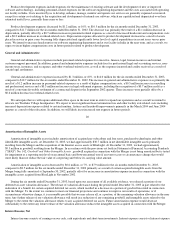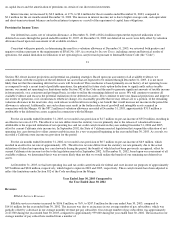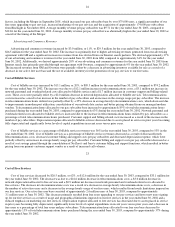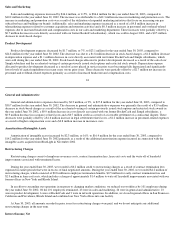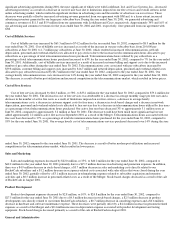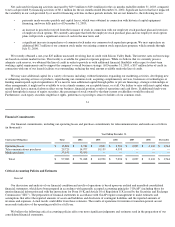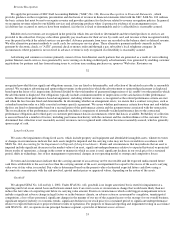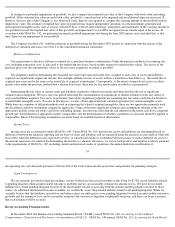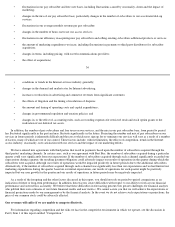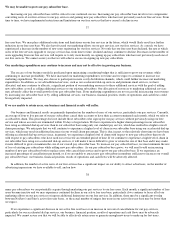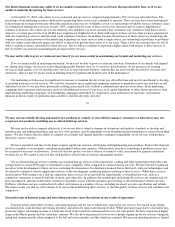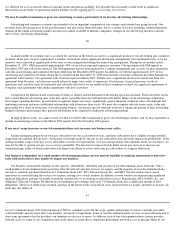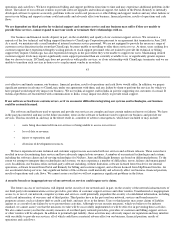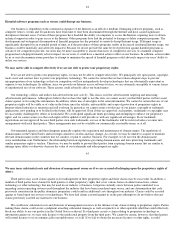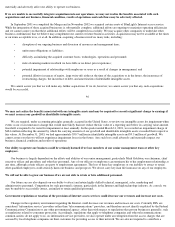Classmates.com 2003 Annual Report Download - page 27
Download and view the complete annual report
Please find page 27 of the 2003 Classmates.com annual report below. You can navigate through the pages in the report by either clicking on the pages listed below, or by using the keyword search tool below to find specific information within the annual report.
In testing for a potential impairment of goodwill, we first compare the estimated fair value of the Company with book value, including
goodwill. If the estimated fair value exceeds book value, goodwill is considered not to be impaired and no additional steps are necessary. If,
however, the fair value of the Company is less than book value, then we are required to compare the carrying amount of the goodwill with its
implied fair value. The estimate of implied fair value of goodwill may require independent valuations of certain internally generated and
unrecognized intangible assets such as our pay subscriber base, software and technology, and patents and trademarks. If the carrying amount of
our goodwill exceeds the implied fair value of that goodwill, an impairment loss would be recognized in an amount equal to the excess. In
accordance with SFAS No. 142, we performed an annual goodwill impairment test during the June 2003 quarter and concluded that, at that
time, there was no impairment of our goodwill.
The Company recorded a $1.4 million reduction in goodwill during the December 2003 quarter in connection with the release of the
deferred tax valuation allowance (see Note 4 to the consolidated financial statements).
Business Combinations
Our acquisitions to date have all been accounted for as purchase business combinations. Under the purchase method of accounting, the
cost, including transaction costs, is allocated to the underlying net assets, based on their respective estimated fair values. The excess of the
purchase price over the estimated fair values of the net assets acquired is recorded as goodwill.
The judgments made in determining the estimated fair values and expected useful lives assigned to each class of assets and liabilities
acquired can significantly impact net income. For example, different classes of assets will have useful lives that differ (e.g., the useful life of
acquired users may not be the same as the useful life of acquired technologies). Consequently, to the extent a longer-lived asset is ascribed
greater value under the purchase method than a shorter-lived asset, there may be less amortization recorded in a given period.
Determining the fair value of certain assets and liabilities acquired is subjective in nature and often involves the use of significant
estimates and assumptions. We use a one-year period following the consummation of acquisitions to finalize estimates of the fair values of
assets and liabilities acquired. Two areas, in particular, that require significant judgment are estimating the fair values and related useful lives
of identifiable intangible assets. To assist in this process, we may obtain appraisals from valuation specialists for certain intangible assets.
While there are a number of different methods used in estimating the value of acquired intangibles, there are two approaches primarily used:
the discounted cash flow and market comparison approaches. Some of the more significant estimates and assumptions inherent in the two
approaches include: projected future cash flows (including timing); discount rate reflecting the risk inherent in the future cash flows; perpetual
growth rate; determination of appropriate market comparables; and the determination of whether a premium or a discount should be applied to
comparables. Most of the foregoing assumptions are made based on available historical information.
Income Taxes
Income taxes are accounted for under SFAS No. 109. Under SFAS No. 109, deferred tax assets and liabilities are determined based on
differences between the financial reporting and tax basis of assets and liabilities and are measured using the enacted tax rates and laws that will
be in effect when the differences are expected to reverse. A valuation allowance is established when necessary to reduce deferred tax assets to
the amount expected to be realized. In determining the need for a valuation allowance, we review both positive and negative evidence pursuant
to the requirements of SFAS No. 109, including current and historical results of operations, the annual limitation on utilization of
34
net operating loss carryforwards pursuant to Section 382 of the Code, future income projections and potential tax-planning strategies.
Legal Contingencies
We are currently involved in legal proceedings, certain of which are discussed elsewhere in this Form 10-K. We record liabilities related
to pending litigation when an unfavorable outcome is probable and we can reasonably estimate the amount of loss. We have not recorded
liabilities for certain pending litigation because of the uncertainties related to assessing both the amount and the probable outcome of those
claims. As additional information becomes available, we continually assess the potential liability related to all pending litigation. While we
currently believe that the liabilities recorded on our balance sheet are sufficient to cover pending litigation for which an unfavorable outcome is
probable and the amount of loss can be reasonably estimated, the outcome of litigation is inherently uncertain, and there can be no assurance
that such estimates will be accurate.
Recent Accounting Pronouncements
In December 2002, the Financial Accounting Standards Board ("FASB") issued SFAS No. 148, Accounting for Stock-Based
Compensation
—
Transition and Disclosure
—
an amendment of FAS 123
. SFAS No. 148 amends SFAS No. 123,
Accounting for Stock
-
Based


